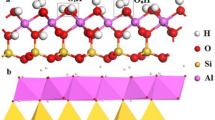Abstract
The surface charge components of 2 Georgia kaolinites of differing degrees of crystallinity (KGa-1 and KGa-2) were determined using procedures based on charge balance concepts. Permanent structural charge density (σ0) was determined by measuring the surface excess of Cs, which is highly selective to permanent charge sites. The values of σ0 determined were -6.3 ±0.1 and -13.6 ± 0.5 mmol kg−1 for kaolinites KGa-1 and KGa-2, respectively. The net proton surface charge density (σH) was determined as a function of pH by Potentiometrie titration in 0.01 mol dm-3 LiCl. Correction from apparent to absolute values of σH was made by accounting for Al release during dissolution, background ion adsorption and charge balance. Lithium and C1 adsorption accounted for the remainder of the surface charge components. Changes in surface charge properties with time were measured after mixing times of 1, 3 and 15 h, the latter representing “equilibrium”. Time-dependent behavior is believed to be caused by mineral dissolution followed by readsorption or precipitation of Al on the mineral surface. Both the point of zero net charge (p.z.n.c.) and the point of zero net proton charge (p.z.n.p.c.) changed with mixing time, generally increasing. The “equilibrium” p.z.n.c. values were approximately 3.6 for KGa-1 and 3.5 for KGa-2, whereas the corresponding p.z.n.p.c. values were about 5.0 and 5.4. The p.z.n.c. results were in good agreement with previous studies, but the values of p.z.n.p.c. were higher than most other values reported for specimen kaolinite.
Similar content being viewed by others
References
Anderson SJ, Sposito G. 1991. Cesium adsorption method for measuring accessible structural surface charge. Soil Sci Soc Am J 55:1569–1576.
Anderson SJ, Sposito, G. 1992. Proton surface charge density in soils with structural and pH dependent charge. Soil Sci Soc Am J 56:1437–1443.
Bolland MDA, Posner AM, Quirk JP. 1976. Surface charge on kaolinites in aqueous suspension. Aust J Soil Res 14: 197–216.
Braggs B, Fornasiero D, Ralston J, St Smart R. 1994. The effect of surface modification by an organosilane on the electrochemical properties of kaolinite. Clays Clay Miner 42:123–136.
Buchanan AS, Oppenheim RC. 1968. The surface chemistry of kaolinite. I. Surface leaching: Aust J Chem 21:2367–2371.
Carroll-Webb SA, Walther JV. 1988. A surface complex reaction model for the pH-dependence of corundum and kaolinite dissolution rates. Geochim Cosmochim Acta 52: 2609–2623.
Charlet L, Sposito G. 1987. Monovalent ion adsorption by an Oxisol. Soil Sci Soc Am J 51:1155–1160.
Charlet L, Schindler PW, Spadini L, Furrer G, Zysset M. 1993. Cation adsorption on oxides and clays: The aluminum case. Aquatic Sci 55:291–303.
Chorover J, Sposito G. 1993. Measurement of soil surface charge components. Technical report, NSF grant EAR9221258. Berkeley: Univ of California. 4. p.
Chorover J, Sposito G. 1995a. Surface charge characteristics of kaolinitic tropical soils. Geochim Cosmochim Acta 59: 875–884.
Chorover J, Sposito G. 1995b. Dissolution behavior of kaolinitic tropical soils. Geochim Cosmochim Acta 59:3109–3121.
Ferris AP, Jepson WB. 1975. The exchange capacities of kaolinite and the preparation of homoionic clays. J Colloid Interface Sci 51:245–259.
Goldberg S, Davis JA, Hem JD. 1996. The surface chemistry of aluminum oxides and hydroxides. In: Sposito G, editor. The environmental chemistry of aluminum, 2nd ed. Boca Raton, FL: CRC Pr. p 271–331.
Gran G. 1952. Determination of the equivalence point in Potentiometric titrations. Part II. Analyst 77:661–671.
Haderlein SB, Schwarzenbach RP. 1993. Adsorption of substituted nitrobenzenes and nitrophenols to mineral surfaces. Environ Sci Technol 27:316–326.
Jepson WB. 1984. Kaolins: Their properties and uses. Phil Trans R Soc Lond A311:411–432.
Kim Y, Cygan RT, Kirkpatrick RJ. 1996. 133Cs NMR and XPS investigation of cesium adsorbed on clay minerals and related phases. Geochim Cosmochim Acta 60:1041–1052.
Lim CH, Jackson ML, Koons RD, Helmke PA. 1980. Kaolins: Sources of differences in cation-exchange capacities and cesium retention. Clays Clay Miner 28:223–229.
Lyklema J. 1987. Electrical double layers on oxides: Disparate observations and unifying principles. Chem Ind 65: 741–747.
Motta MM, Miranda CF. 1989. Molybdate adsorption on kaolinite, montmorillonite, and illite: Constant capacitance modeling. Soil Sci Soc Am J 53:380–385.
Nordstrom DK, May HM. 1996. Aqueous equilibrium data for mononuclear aluminum species. In: Sposito G, editor. The environmental chemistry of aluminum, 2nd ed. Boca Raton, FL: CRC Pr. p 39–80.
Olphen H van, Fripiat JJ. 1979. Data handbook for clay materials and other non-metallic minerals. NY: Pergamon Pr. p 13–18.
Parks GA. 1967. Aqueous surface chemistry of oxides and complex oxide minerals. In: Equilibrium concepts in natural water systems. Washington, DC: Am Chem Soc. p 121–160.
Schindler PW, Liechti P, Westall JC. 1987. Adsorption of copper, cadmium and lead from aqueous solution to the kaolinite/water interface. Neth J Agric Sci 35:219–230.
Sposito G. 1992. Characterization of particle surface charge. In: Buffle J, van Leeuwen, editors. Environmental particles. Chelsea, MI: Lewis Publ. p 291–314.
Steel RGD, Torrie JH. 1960. Principles and procedures of statistics, with special reference to the biological sciences. NY: McGraw-Hill. 48. p.
Stumm W 1992. Chemistry of the solid-water interface. NY: J Wiley. 42. p.
Sverjensky DA. 1994. Zero-point-of-charge prediction from crystal chemistry and solvation theory. Geochim Cosmochim Acta 58:3123–3129.
Wieland E, Stumm W 1992. Dissolution kinetics of kaolinite in acidic aqueous solutions at 25 °C. Geochim Cosmochim Acta 56:3339–3355.
Xie Z, Walther JV. 1992. Incongruent dissolution and surface area of kaolinite. Geochim Cosmochim Acta 56:3357–3363.
Zhou Z, Gunter WD. 1992. The nature of the surface charge of kaolinite. Clays Clay Miner 40:365–368.
Author information
Authors and Affiliations
Rights and permissions
About this article
Cite this article
Schroth, B.K., Sposito, G. Surface Charge Properties of Kaolinite. Clays Clay Miner. 45, 85–91 (1997). https://doi.org/10.1346/CCMN.1997.0450110
Received:
Accepted:
Published:
Issue Date:
DOI: https://doi.org/10.1346/CCMN.1997.0450110




